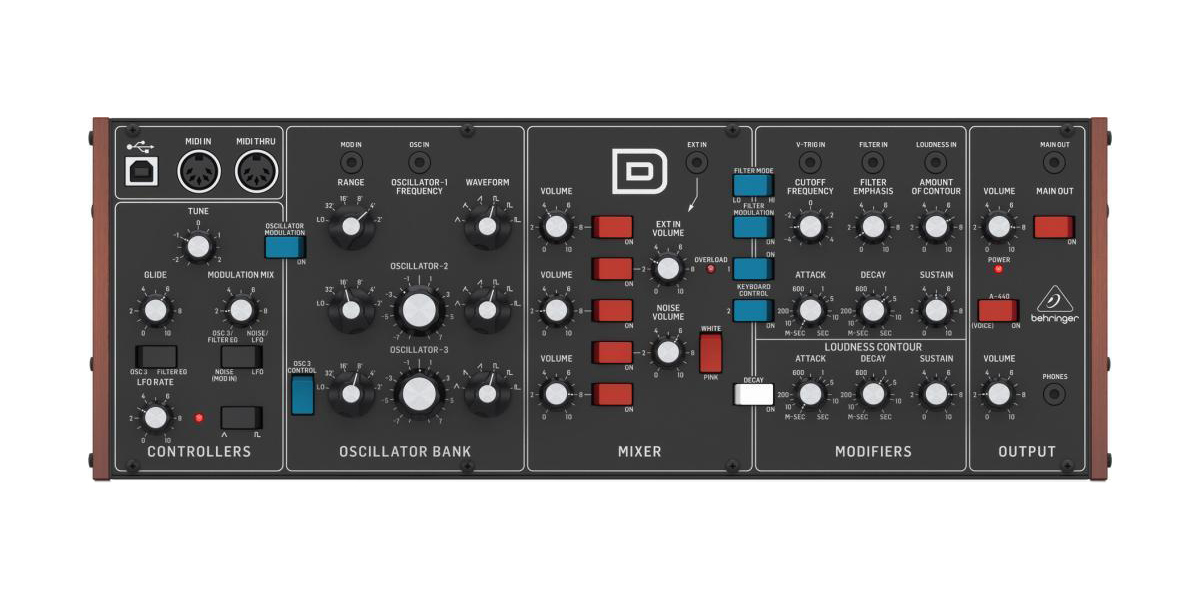It doesn’t even matter so much that the sound will be generated within another box with other components and won’t be 100% identical. Anyway you know it went great for Arturia which turned the tide and streamed again but as a serious and respectable synth maker. At least that’s what customers and competitors think today. They started with Moog clones (which is a vulnerable journey) and look where they are now.

Behringer D has been a hot topic for all musicians lately. This analog eurorack synthesizer was inspired by Minimoog featuring the same analog signal path architecture: 3 VCOs (5 waveforms), a 24 dB low pass and high pass resonant ladder filter and LFO (triangle and square waveforms), noise generator. Some modern connectivity will be added (USB and MIDI support – up to 16 MIDI channels with priority options) the device is going to be compatible with any eurorack synth. There is an important detail – to make it really authentic thin film resistors, JFET transistors and polymer capacitors are used to provide amplitude frequency response stability.
The feature which might get Dave Smith nervous is the Poly Chain function which allows combining up to 16 synths through MIDI – it’s something similar what Dave Smith Instruments offer. Anyway (and probably contrary to expectations of modular system fans) the renderings of the proposed Behringer D show very limited CV support, primarily offering CV/Gate control and audio input. But there will be a classic double audio output with different levels.
So far Behringer hasn’t crossed the line where Behringer D is still a project because the company is waiting what the response is going to be. And if it’s positive they promise to get down to the creation of a prototype.
The price is announced to be $400 (yet theoretically) which definitely doesn’t seem to be high, although we have some questions. First of all it’s a clone. But there are so many new and second hand Moog instruments on the market as well as DSI, Korg, Arturia and Elektron synthesizers. Yes, it’s a matter of price. But Behringer D is just a monophonic modular synthesizer (three VCOs per voice but no paraphonic mode). It’s more of a tone generator with waveform processing extra functions though it lacks the essence – no patch memory.
There goes the problem:
- “Behringer” means “budget”
- MIDI Poly Chain is a more typical function for pricey instruments
- Why giving Poly Chain if there is no patch memory?
Let’s say you went broke and bought 4 Behringer D modules in order to integrate them instead of purchasing fully functional DSI REV2. You started to make it right with the settings and succeeded. And? That’s it. There is still no patch memory whatever you do – that turns your chain of Behringers into nothing more than a static tool, you just can’t save anything. Want a new sound? Make some magic – starting all over again. Well, don’t you think it’s much better (better and cheaper than 4 Behringer D units) to buy Elektron Analog Four with stunning functionality or a trustworthy Prophet `08 Desktop which has proven to be alright – both of them feature classy sound and price about $1100-1200 making it 20% less than 4 Behringer D models would cost you. Arturia Matrixbrute is 20% more expensive but it offers truly unprecedented connectivity choice allowing you to use all the three VCOs to the fullest and get as much (if not more) as 4 Behringers can give you offering 12 VCOs in total. But Behringer is smart enough to make module in the eurorack format – like that he attracts musicians who adore classic instruments and Moog-like synths in particular.
Though we can’t deny that Uli Behringer is doing great with making analog instruments popular again. So he actually triggered the cost cutting mechanism and while Behringer keeps on being happy and rich others have to surrender to the market conditions and cut down the price (for digital synthesizers as well).
Just think of it – in half a year we’ll have a chance to get Model D and pay 10 times less than we would need to a year ago. We’ll produce this sound personally and we’ll hear it from our own speakers! This is worth forgetting that patch memory issue and “Behringer” logo on the front panel.

